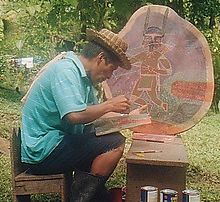- Guaymí people
-
Guaymí Total population 200,000-250,000 Regions with significant populations Panama, Costa Rica Languages The Guaymí or Ngäbe are an indigenous group living mainly within the Ngäbe-Buglé comarca (native american province) in the Western Panamanian provinces of Veraguas, Chiriquí and Bocas del Toro, as well as in the indigenous town of Conte, Costa Rica near the extreme southern tip of the country. Guaymí is the traditional term for the Ngäbe and is derived from the Buglere term for them (guaymiri). Local newspapers and other media often alternatively spell the name Ngäbe as Ngobe or Ngöbe because Spanish does not contain the sound represented by ä, a low-back rounded a, slightly higher than the English aw in the word saw and Spanish speakers hear ä as either an o or an a. The language spoken by the Ngäbe is Ngäbere. There are approximately 200,000-250,000 speakers of Ngäbere today. A sizable number of Ngäbe have migrated to Costa Rica in search of work on the coffee fincas. Ngäbere and Buglere are distinct languages in the Chibchan language family. They are mutually unintelligible.
The Spanish found three distinct Guaymi tribes in what is today's western Panama; each was named after its chief and each spoke a different language. The chiefs were Nata, in the Province of Cocle, and Parita in the Azuero Peninsula and the greatest chief Urraca in what is now Veraguas Province.
Urraca became famous by defeating the Spaniards time after time, and forced Diego de Albitez, a captain of the Spanish, to sign a peace treaty in 1522. He was nonetheless betrayed and sent in chains to the town of Nombre de Dios on the Atlantic coast – according to historian Bartolomé de las Casas – Urraca escaped and made his way back to the mountains, vowing to fight the Spaniards unto death. And he fulfilled his vow. Urraca was so feared by the Spaniards that they avoided combat with his men. When Urraca died in 1531 he was still a free man.
The Guaymies were divided into two large groups: those of the lowlands along the Atlantic coast, and those of the tropical forest in the highlands of Veraguas and Chiriquí Province. Never surrendered, fighting until the collapse of the Spanish empire. When Panama broke away from Spain and joined Colombia in the early 19th Century, the Guaymies remained in the mountains. Only now slowly are some assimilating into modern society.
A few Guaymi have been able to acquire solar electricity (through an electrification project), as well as cell phone service. However, most still live below the poverty level. Because of the rugged geography, efforts to bring roads and new infrastructure to Guaymi reservations has been limited. Nevertheless, some Guaymi choose to live secluded lives away from modern societies.
Today the Guaymí are subsistence farmers, and agricultural laborers. On the Pacific slopes, the main crops are rice, corn, yucca, otoy, ñame (both tubers), several species of beans. Small-scale livestock production of chickens and pigs is maintained and in the higher elevations is supplemented by hunting (where permitted). The primary crop for the Guaymí on the Atlantic slopes is green bananas.
In order to survive many Guaymí resort to working in the cash economy. Coffee picking, working on large cattle farms and on banana plantations provide the main source of cash. Also, once made for battle and ceremony, some Guaymi sell beaded necklaces on the side of the roads in Panama.
The Guaymi women make many traditional crafts, both for their own use and their families', but also to sell as extra income. These include handmade bags from plant fibers called "kra" in their language, colorful dresses called "nagua" and beaded bracelets and necklaces. The men of the Guaymi have a tradition of weaving hats from plant fibers.
Today, there is a small Baha'i community developing within the Guaymi community after the first primitive Baha'i center was built in El Progreso.
External links
- Ngobe Bugle (English)
- US Library of Congress – Guaymí
- [1] -a Ngobe development organization
- [2] – a Ngobe Botanical garden
Categories:- Ethnic groups in Panama
- Indigenous peoples in Panama
Wikimedia Foundation. 2010.

